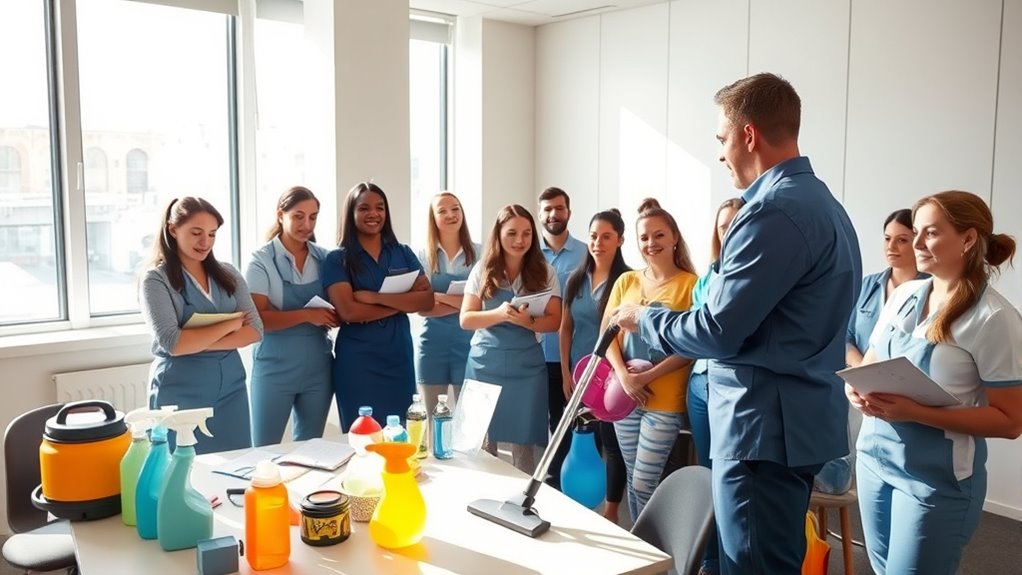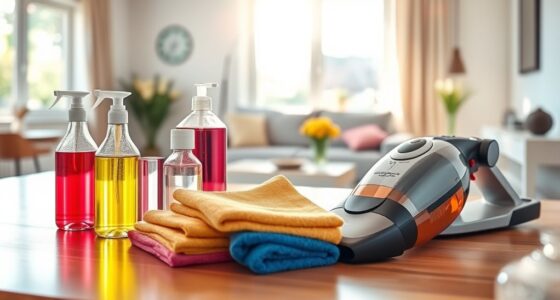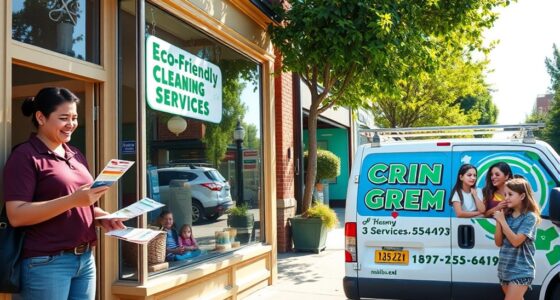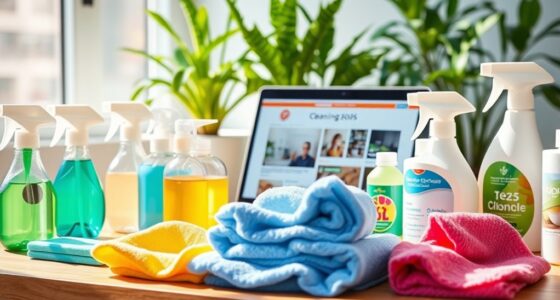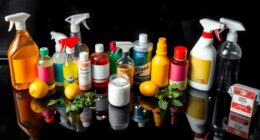To train new cleaning employees effectively, start by developing clear Standard Operating Procedures (SOPs) for consistent cleaning standards. Use job forms and checklists to enhance efficiency and track progress. Create a detailed employee handbook that outlines expectations and policies. Establish a structured training schedule with hands-on practice sessions and customer interaction training to improve people skills. Regularly evaluate performance and provide additional educational resources. There’s so much more you can implement to guarantee their success.
Key Takeaways
- Develop a structured training schedule with clear daily objectives focused on specific cleaning tasks and procedures.
- Utilize hands-on practice sessions to reinforce skills and ensure understanding of cleaning techniques and equipment usage.
- Incorporate role-playing scenarios to enhance customer interaction skills and teamwork among new employees.
- Provide comprehensive safety training covering chemical safety, PPE use, and emergency procedures to promote a safe working environment.
- Regularly assess employees’ progress through feedback sessions and performance evaluations to identify areas for improvement and continued learning.
Develop Standard Operating Procedures for Consistency

To guarantee your cleaning team delivers consistent results, it’s essential to develop clear and concise Standard Operating Procedures (SOPs) for each cleaning service. By outlining consistent guidelines, you ascertain that every employee understands the expectations for different environments, whether residential or commercial.
Incorporate task-specific checklists in your training program, providing step-by-step instructions for cleaning tasks like kitchens and bathrooms. This promotes uniformity and enhances employee retention, as staff feel confident in their roles.
Don’t forget to monitor adherence to SOPs during evaluations, reinforcing the importance of quality standards. Regularly review and update these procedures based on employee feedback and industry advancements, and consider using visual aids to cater to various learning styles for better understanding. Additionally, ensure that your team is familiar with filtration systems to effectively remove allergens and maintain a clean environment.
Create Job Forms and Checklists for Efficiency

Job forms and checklists are essential tools that streamline the cleaning process and enhance efficiency for your employees. By detailing specific tasks and expectations, these tools guarantee clarity for new employees, promoting consistency in their work.
Implementing checklists allows cleaners to track their progress and verify task completion, fostering accountability throughout their assignments. Standardized job forms help document client preferences and special instructions, which aids new cleaners in understanding unique requirements.
Incorporating time management features into checklists teaches new employees to prioritize tasks effectively, guaranteeing they complete jobs within designated time frames. Regularly reviewing and updating job forms and checklists based on feedback maintains their relevance, ultimately supporting ongoing training and improving operational efficiency.
Write a Comprehensive Employee Handbook

Creating an extensive employee handbook is vital for setting clear expectations and fostering a positive workplace culture. Your handbook should include a company overview, mission statement, and contact information to convey your values.
An employee handbook is essential for establishing expectations and nurturing a positive workplace culture.
Clearly outline behavioral expectations, attendance policies, dress codes, and safety procedures to guarantee everyone adheres to company standards. Incorporate payroll information, detailing pay schedules and methods, so new employees understand their compensation structure.
Provide detailed training standards and job descriptions that specify responsibilities and performance expectations, essential for maintaining service quality.
Remember to review and update the handbook annually to reflect any changes in company policies or legal requirements, making sure it remains relevant and useful for current and future employees.
Establish a Structured Training Schedule
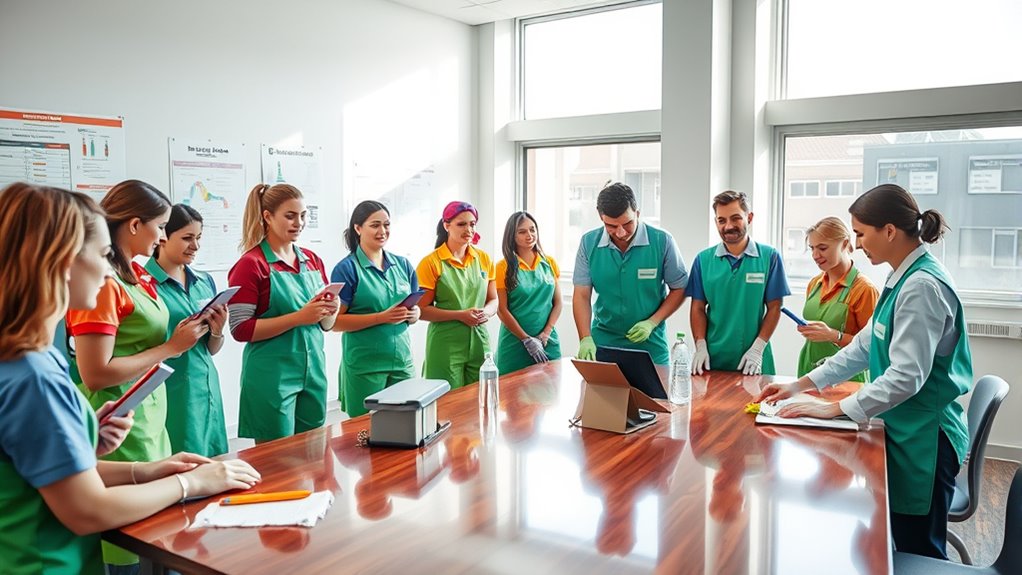
To set your cleaning employees up for success, establish daily learning objectives that focus on specific tasks. Break down the training into step-by-step procedures, ensuring they understand each aspect before moving on. This structured approach helps reinforce their skills and boosts confidence as they progress. Additionally, consider monitoring dietary intake to ensure employees are energized and focused during their shifts.
Daily Learning Objectives
Establishing a structured training schedule is essential for effectively onboarding cleaning employees, as it helps them focus on specific learning objectives each day.
During the training process, dedicate each day to one aspect of cleaning staff training, starting with basic cleaning techniques like dusting and sanitizing. This prevents overwhelming new hires and allows them to build their knowledge and skills gradually.
Incorporate hands-on practice sessions in your training sessions so they can apply what they’ve learned under supervision, boosting their confidence. Use tailored checklists for each task to guarantee thoroughness.
Finally, schedule regular assessments, like quizzes or practical evaluations, at the end of each day to reinforce learning and identify areas for improvement.
Step-by-Step Procedures
After setting daily learning objectives, it’s time to implement a structured training schedule that breaks down the onboarding process into manageable modules.
This approach guarantees new employees absorb information gradually, becoming effective employees in no time.
Here’s how to organize your cleaning service training:
- Daily Sessions: Schedule focused sessions on specific cleaning tasks, each lasting no more than two hours for better retention.
- Hands-On Practice: Incorporate a mix of classroom learning and shadowing opportunities over two weeks to cover proper cleaning techniques and personal protective equipment (PPE).
- Feedback Mechanisms: Use checklists and quizzes to reinforce learning and adjust the training schedule based on feedback for continuous improvement.
With clear communication throughout, you’ll set your training cleaners up for success!
Incorporate People Skills and Customer Interaction Training
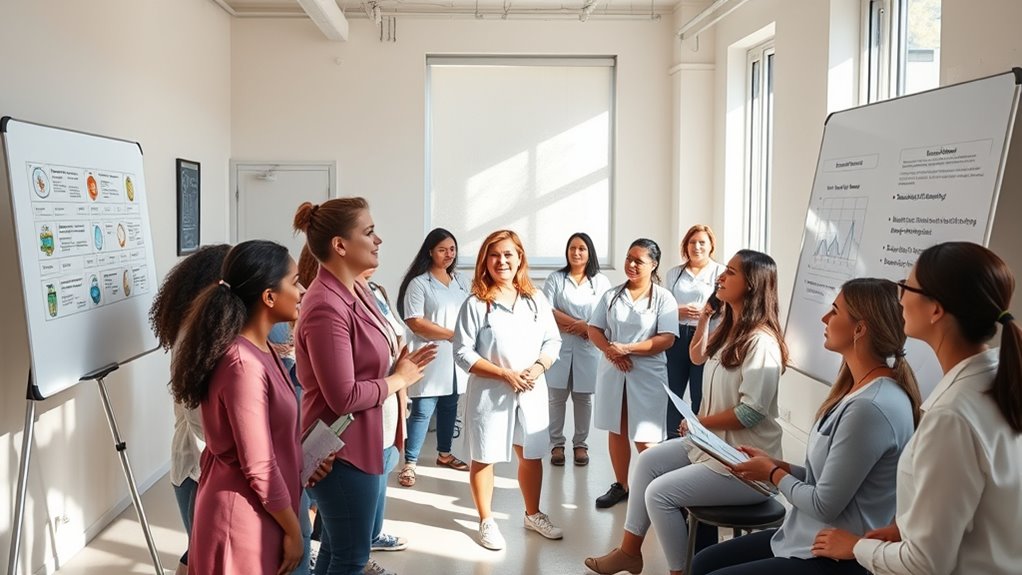
When training your cleaning employees, it’s essential to incorporate role-playing scenarios that boost their communication skills and teamwork.
This hands-on approach not only helps them practice interactions but also fosters collaboration among team members.
Role-Playing Scenarios
To effectively prepare cleaning employees for real-world interactions, incorporating role-playing scenarios into training can be invaluable. These scenarios allow new hires to practice communication skills and customer service in a safe space, boosting their confidence.
Here are three key benefits of role-playing:
- Simulated Situations: Employees tackle common challenges, like managing difficult clients or scheduling conflicts, enhancing their problem-solving skills.
- Real-Time Feedback: After each scenario, feedback sessions help identify strengths and areas for growth, refining their abilities.
- Positive Work Environment: With improved skills, employees feel equipped to handle client interactions, fostering a supportive atmosphere.
Integrating role-playing into your training program sets the stage for excellent service and lasting client relationships.
Communication Skills Development
Effective communication is essential for cleaning employees, as it enables them to connect with clients and understand their needs.
Incorporate role-playing scenarios into your training sessions to help new cleaning staff practice effective communication and professionalism. Emphasize active listening techniques, which can boost customer satisfaction by 60%.
Providing regular feedback on interpersonal skills during evaluations can enhance performance by up to 39%. Encourage new cleaners to offer service upgrades or discounts during interactions, empowering them to build rapport with clients.
This not only fosters better communication but also strengthens relationships and brand loyalty. Remember, developing strong interpersonal skills among your cleaning staff is key to ensuring client satisfaction and maintaining a positive work environment. Additionally, engaging in continuous learning will help your employees adapt to changing client needs and enhance their service quality.
Teamwork and Collaboration
Here are three strategies to enhance teamwork and collaboration:
- Role-Playing Scenarios: Use these during training to boost confidence in customer interactions and communication skills. Implementing visualization techniques can also help employees mentally prepare for various customer service situations they might encounter.
- Team-Building Exercises: Engage your staff in activities that strengthen relationships, promoting a supportive work environment.
- Open Feedback Sessions: Encourage sharing experiences and challenges in team meetings, helping to identify areas for improvement. Additionally, fostering open communication can enhance emotional support among team members, similar to how it’s vital during challenging times for children.
Implement a Workplace Safety Program
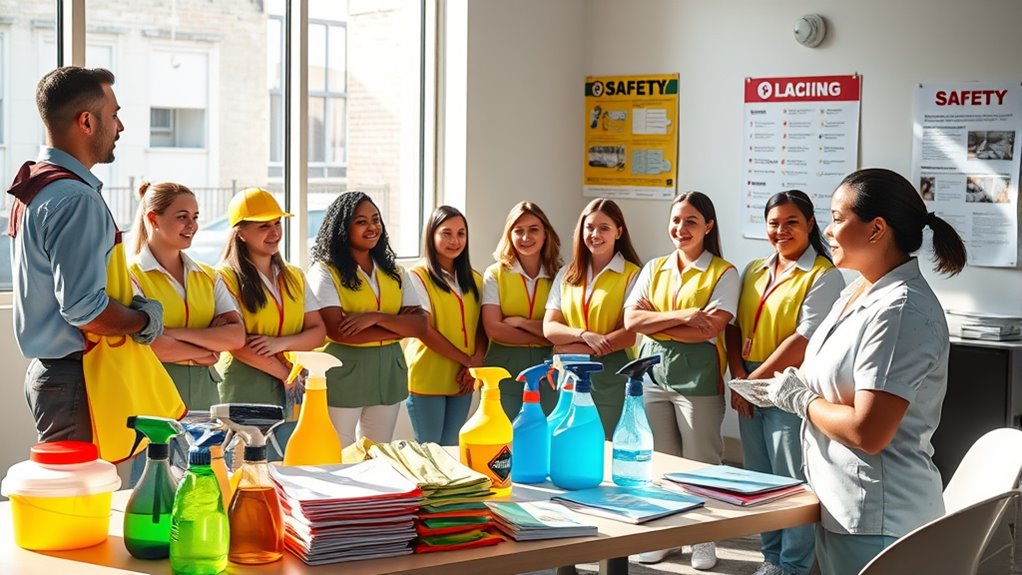
Implementing an extensive workplace safety program is essential for protecting your cleaning employees and ensuring a safe environment. This program should include thorough safety training that covers chemical safety and the proper use of personal protective equipment (PPE).
| Safety Element | Description |
|---|---|
| Training Courses | Educate employees on hazard communication and MSDS. |
| Personal Protective Equipment (PPE) | Provide gloves, masks, and goggles to minimize exposure. |
| Safety Drills | Conduct regular drills to reinforce emergency procedures. |
Offer Additional Education and Skill Development
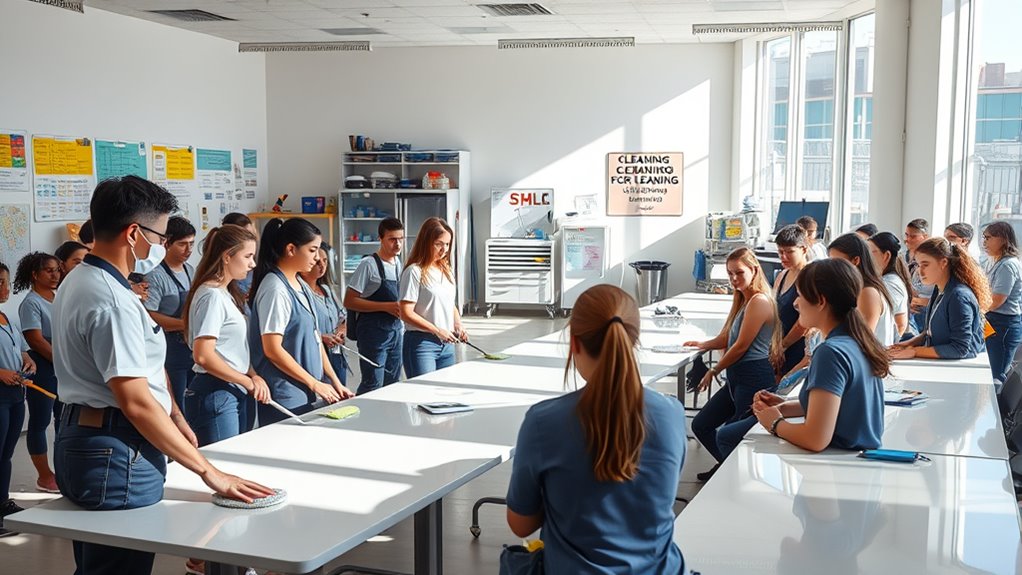
To guarantee your cleaning employees excel in their roles, offering additional education and skill development is essential.
Here are three effective ways to enhance their training:
- Access Workshops and Courses: Provide opportunities for employees to learn the latest cleaning techniques and safety protocols through industry-specific workshops.
- Encourage Certification Programs: Support participation in programs from organizations like ISSA and the American House Cleaners Association, empowering cleaners with specialized knowledge and credentials.
- Promote Continuous Learning: Offer self-study resources and training manuals to keep your staff updated on best practices and industry standards.
Evaluate Performance Regularly for Continuous Improvement
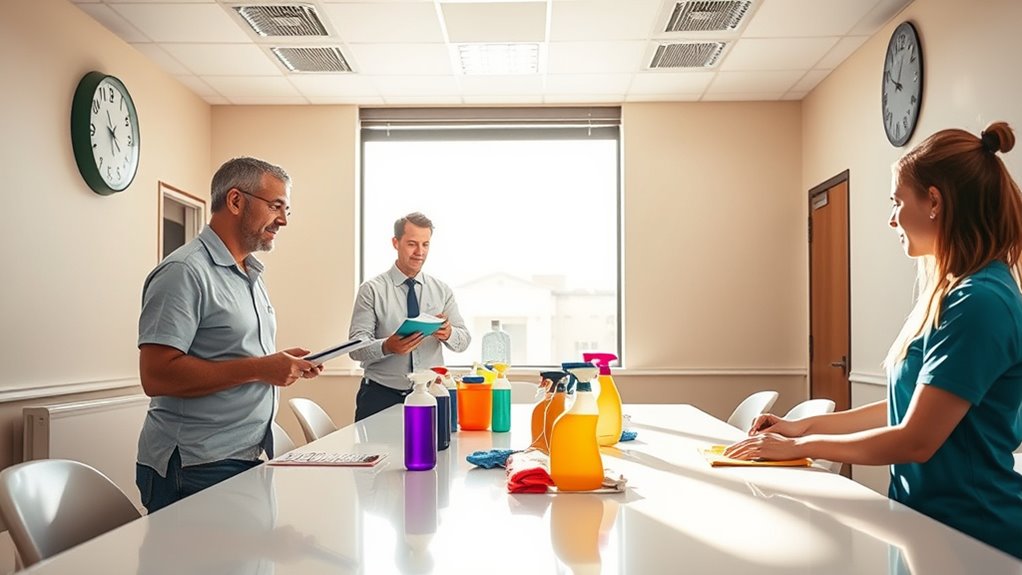
Regularly evaluating your cleaning employees’ performance is essential for fostering continuous improvement and maintaining high service standards. Conduct performance reviews at least quarterly to assess adherence to cleaning standards and pinpoint areas for improvement.
Utilize client feedback surveys after each job to gather insights on employee performance and service quality. Monitor callbacks and complaints as opportunities for additional training to reinforce best practices among your staff.
Gather client feedback after each job to enhance employee performance and address service quality through targeted training.
Additionally, implementing a performance bonus program can motivate employees and recognize high performers, enhancing overall service quality.
Don’t forget to regularly review training materials to guarantee they align with observed performance metrics and evolving industry standards, assuring your team is always equipped for success.
Utilize Technology and Resources for Effective Training
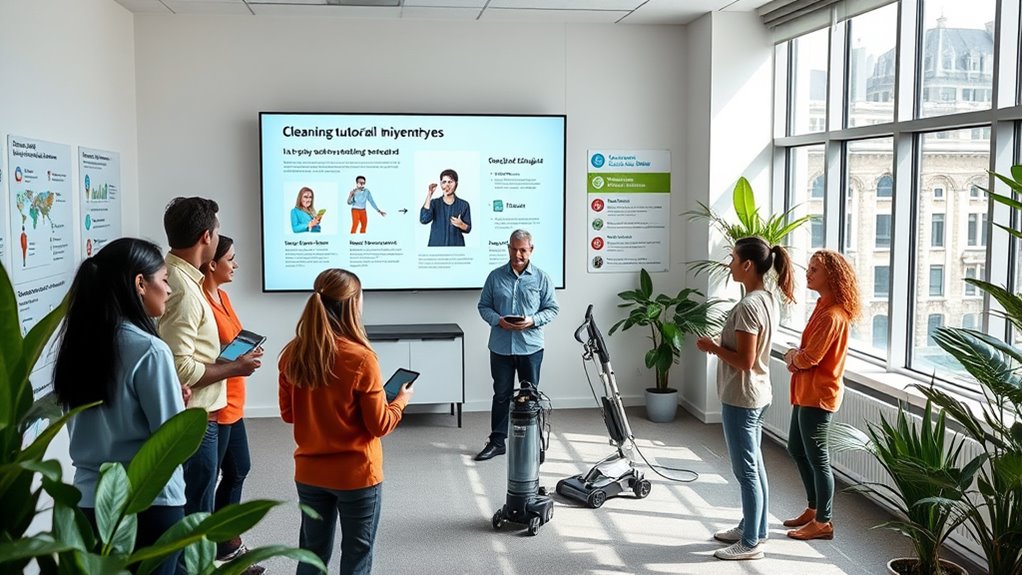
As you look to enhance your training program, leveraging technology and resources can considerably streamline the process and improve outcomes for your cleaning employees.
Here are three effective strategies:
- Access an online library of training resources, including videos and tutorials, so your team can learn at their own pace.
- Utilize technology platforms for industry-related cleaning courses, webinars, and virtual workshops to keep staff updated on cleaning best practices.
- Implement job tracking features that enable real-time feedback and performance monitoring, allowing for immediate adjustments in training methods.
Foster a Supportive and Collaborative Training Environment
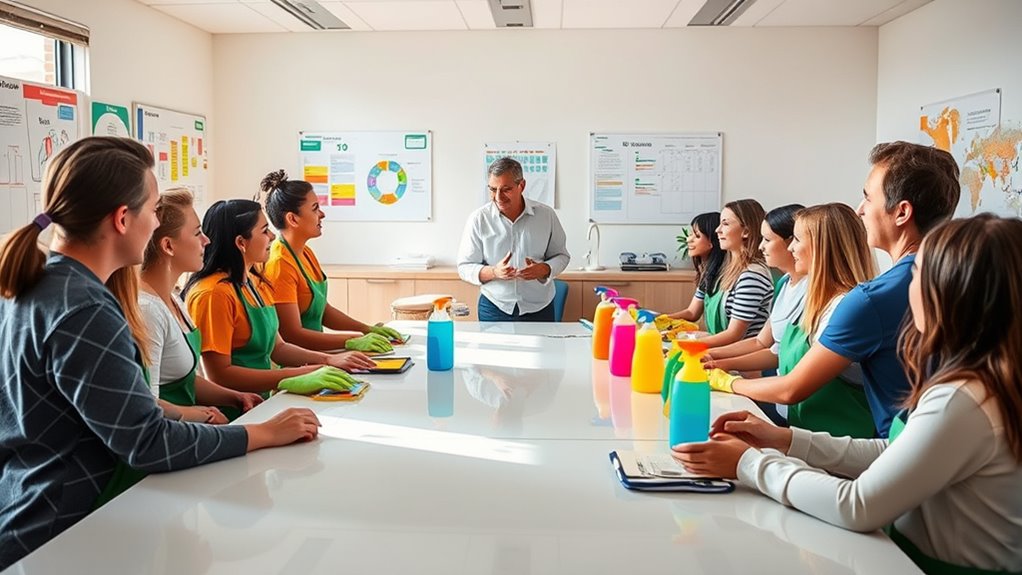
Creating a supportive and collaborative training environment is essential for fostering a strong team dynamic among cleaning employees.
Implement a buddy system where new cleaners are paired with experienced staff, providing guidance and a sense of belonging, which can enhance retention rates greatly.
Encourage open communication, allowing new team members to ask questions and share ideas, improving collaboration.
Regular team-building activities help strengthen relationships and contribute to a positive atmosphere.
Utilize feedback sessions to discuss challenges and successes, reinforcing support and continuous improvement among team members.
Don’t forget to recognize and celebrate milestones, boosting morale and motivating everyone. Additionally, promoting effective co-parenting communication can help employees balance their work and family commitments, leading to a more focused and productive workforce.
Frequently Asked Questions
How to Train a New Housekeeper?
To train a new housekeeper, start with a structured onboarding program that covers essential policies, techniques, and safety protocols.
Use hands-on training to let them practice cleaning tasks under supervision, gradually increasing complexity.
Provide a detailed job description to set clear expectations.
Assign a mentor for guidance and support, and emphasize quality standards with checklists.
Regular evaluations will help you give constructive feedback, ensuring they feel confident and valued in their role.
How Do You Train Housekeeping Staff?
Training housekeeping staff is like planting seeds in a garden. You prepare the soil with a detailed training manual outlining your expectations.
Incorporate hands-on sessions where they can practice and hone their skills, nurturing their confidence. Provide checklists to help them track progress, ensuring no task is overlooked.
Pair them with experienced mentors to share wisdom. Regular evaluations act as sunlight, guiding them towards continuous improvement and blossoming into skilled professionals.
How Much Should I Charge for 2 Hours of Cleaning?
When you’re deciding how much to charge for two hours of cleaning, consider your regional market rates.
Typically, you might charge between $50 and $100, depending on the home’s size and the cleaning level required.
If you offer additional services like carpet cleaning, factor those into your pricing as well.
Providing a flat rate can simplify estimates for clients, ensuring they understand the total cost upfront and enhancing their satisfaction with your service.
What Are the Methods of Training Used for Cleaners?
When you think about training methods for cleaners, hands-on sessions stand out. You’re not just watching; you’re actively cleaning and using equipment, building confidence.
Pairing with a mentor can also make a difference, as they share tips and tricks. Structured onboarding breaks down information, making it easier to grasp.
Plus, using technology like video training boosts skills on demand. Ongoing sessions keep you updated and sharp, ensuring you excel in your role.
Conclusion
In the end, training your new cleaning employees isn’t just about dusting and mopping; it’s about building a team that shines together. Picture each person, armed with checklists and skills, moving like a well-oiled machine, transforming spaces into sparkling havens. As you nurture their growth and celebrate their successes, you’ll create an environment where everyone thrives. By investing in their training, you’re not just cleaning homes—you’re crafting a culture of excellence that resonates in every corner.

